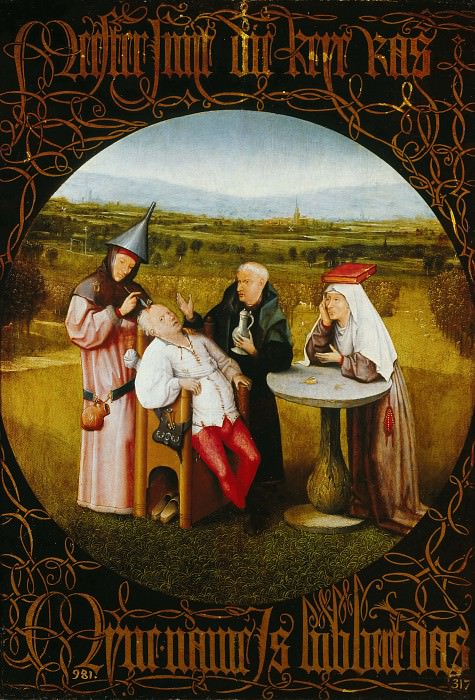The Cure of Folly (workshop or follower) Hieronymus Bosch (1450-1516)
Hieronymus Bosch – The Cure of Folly (workshop or follower)
Edit attribution
Download full size: 3467×5110 px (2,7 Mb)
Painter: Hieronymus Bosch
Location: Prado, Madrid.
"The Extraction of the Stone of Folly" is one of Bosch’s earliest works that has come down to this day. At a glance, from the overall composition and the title of the painting, the main purpose of the painting - the motif of folly - becomes immediately clear. In terms of any pictorial attitude, this work is still far from a pictorial understanding of the painting. You can also find a large number of anatomical errors. Separately, I would like to say that the work is done in monochrome, a little reddish shades, because of which the entire composition looks a little dry.
Description of Hieronymus Bosch’s painting The Extraction of the Stone of Folly
"The Extraction of the Stone of Folly" is one of Bosch’s earliest works that has come down to this day. At a glance, from the overall composition and the title of the painting, the main purpose of the painting - the motif of folly - becomes immediately clear.
In terms of any pictorial attitude, this work is still far from a pictorial understanding of the painting. You can also find a large number of anatomical errors.
Separately, I would like to say that the work is done in monochrome, a little reddish shades, because of which the entire composition looks a little dry. The situation is difficult with the landscape that is in the background, it is rather stingy and poorly designed.
But that’s not the point of this painting. In this case, there is a semantic burden on the viewer in the first place. The work clearly conveys the artist’s idea, which immediately unfolds and catches the eye.
I would like to mention that Bosch would very often encounter such a format in his other works. If we note the format of the tondo, in contrast to other Italian masters, such as Raphael or Botticelli, with whom the circle is an ideal figure, in Bosch’s understanding the circle is the meaning of universality.
The following fact is interesting: when the master from Holland begins to enclose, in a circle, some image, he implies that this case, far from being unique, is an allegory of all people on the planet.
As for the text, which is written at the top and bottom of the circle, it fully describes the situation that is depicted on the canvas. It says that among the dull landscape, nestled 4 people who do not know how they ended up here. The painting is really striking in its conception.
Кому понравилось
Пожалуйста, подождите
На эту операцию может потребоваться несколько секунд.
Информация появится в новом окне,
если открытие новых окон не запрещено в настройках вашего браузера.
You need to login
Для работы с коллекциями – пожалуйста, войдите в аккаунт (open in new window).













![Hieronymus Bosch - The Garden of Paradise [Workshop]](http://cdn.gallerix.asia/j/B/1400476940/8347.webp)






COMMENTS: 1 Ответы
УДАЛЕНИЕ КАМНЕЙ ГЛУПОСТИ
Беззубые, роняют слюни,
Толпятся шарлатана вкруг.
Играет солнышко в июне,
А псевдоврач вершит свой труд.
Он камни глупости изымет
Из чаши черепа – мастак.
Его удача не покинет,
И сам себе едва ли враг.
Изъять бы глупость из живущих!
Изгнать бы шарлатанов зла!
Из грязных чаш так много пьющих,
А жизни столь вода светла.
You cannot comment Why?
The background of the painting suggests a rural landscape with fields, trees, and distant buildings or a town under a pale sky. The entire scene is framed within an ornamental border, featuring intricate gold designs on a black background, with text in Old Dutch at the top and bottom, dating it to 1581.
The subtext of The Cure of Folly is a critique of ignorance and charlatanism, particularly in the realm of medicine and pseudo-science. The title itself is an ironic commentary, implying that the procedure being performed is foolish rather than a cure. The conical hat worn by the surgeon is a symbol often associated with folly or a jesters hat, further reinforcing this interpretation. The open book on the table and the coin could symbolize knowledge and worldly gain, respectively. The womans presence and demeanor might suggest skepticism towards the efficacy of the treatment or the competence of the practitioners. The overall message likely warns against placing faith in quackery and emphasizes the importance of true wisdom and discernment.